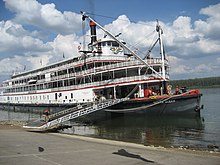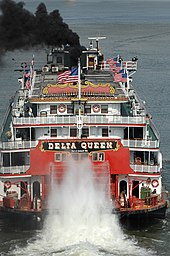Delta Queen
|
||||||||||||||
|
||||||||||||||
|
||||||||||||||
|
||||||||||||||


The Delta Queen is a American rear - wheel steamer , which in 1927 together with the sister ship Delta King for the regular service San Francisco - Sacramento in Stockton (California) was launched. As one of the few originally preserved paddle steamers in the United States, it is both listed in the " National Register of Historic Places " and registered as a " National Historic Landmark ". It was not until 1946 that the ship was transferred to the Mississippi.
construction
The hull consists of galvanized steel segments that were prefabricated in Europe at the William Denny & Brothers shipyard in Dumbarton, Scotland.In 1926 the parts (including those of the Delta King ) were transported by ship to the west coast of the USA, where the two steamers were assembled in Stockton, California. The drive is a compound steam engine with a 3.05 m stroke and an output of 2,000 hp. The high pressure cylinder has a diameter of 0.66 m, the low pressure cylinder measures 1.33 m. The paddle wheel with 28 blades has a diameter of 8 m and a width of 6.5 m. The steering was originally carried out via four oars in front of the paddle wheel. Later (1948) two additional oars were installed behind the paddle wheel; In addition, a bow thruster powered by a diesel engine was installed as a maneuvering aid .
In the hull are the cabins for the crew, the auxiliary machines, the steam boiler and the storage tanks for fuel, water and oil.
The Delta Queen has four decks, the main deck with the machinery in the rear half, the restaurant in front of it and storage space in the front area and a large staircase to the passenger deck. The three passenger decks:
- the "Cabin Deck" with 22 cabins, a library and a lounge,
- the "Texas Deck" with 34 cabins and
- the "Sun Deck" with 32 cabins, including four luxury cabins,
are very luxurious. Above is a sundeck and the wheelhouse. The deck structure was made from wood by the California Transportation Company in Stockton and lavishly decorated and clad. A steam organ is installed on the top deck . In the past, the front part of the main deck was used as a cargo deck.
history
The 1920s and 1930s
The Delta Queen and her sister ship Delta King - called the "Million Dollar Boats" - were built between 1924 and 1927 in Dumbarton, Scotland, and in Stockton. The two barges were commissioned by their owner, California Transportation Co., to replace the Fort Sutter and Capital City ships . The Delta Queen was launched on December 12, 1925 - the superstructure had not yet been completed - and was put into service on May 20, 1927. The two ships ran in opposite directions overnight on the so-called "Delta Route" between San Francisco and Sacramento; this route led over the San Francisco Bay and the Carquinez Strait through the Sacramento-San Joaquin River Delta and the Sacramento River . The luxury of the two “riverboats” were an expression of the “Roaring Twenties” , and because of the remote delta it was relatively easy to bypass prohibition .
However, when bridges like the Golden Gate Bridge , the Bay Bridge and the Carquinez Bridge opened in the mid-1930s, significantly easing car traffic from San Francisco to the north and east, steam shipping declined rapidly and the California Transportation Co. had to file for bankruptcy in 1935 . From around this point in time, the two ships only operated in the summer season, the last regular "Delta Route" was operated on September 29, 1940 (although not known at the time).
In World War II
After the Second World War began, the two steamers were rented by the United States Navy and used as temporary barracks on Treasure Island . In the fall of 1941 they were returned to the California Transportation Co. to be overhauled in Stockton. Due to the attack on Pearl Harbor on December 7, 1941, the two steamers were needed again by the Navy and converted into hospital ships on which the wounded arriving in the bay were cared for. At this time, the two ships were also bought by the Navy, the Delta Queen was operated as the YHB-7 ("Yard House Boat" - "Wohnschiff").
When the hospital capacities were no longer needed, they were used as military ferries between the various installations - Treasure Island, Alameda Naval Air Station , Fort Mason and the San Francisco Pier - in San Francisco Bay; the registration was changed to YFB-56 ("Yard Ferry Boat" - "Ferry").
During the historic founding conference of the United Nations from April 25 to June 26, 1945 in San Francisco, the Delta Queen was used for receptions and excursions for the delegates of the 50 nations. At the beginning of 1946, the two ships were removed from the Navy register and transferred to the " Mothball Fleet " at Suisun Bay .
The 1950s to 1980s
On December 17, 1946, the Delta Queen was bought by the Greene Line Steamers Company in Cincinnati . On April 19, 1947, the tug Osage - with the Delta Queen in tow - set out on a legendary journey through the Panama Canal . After 29 days, she had covered a distance of 5,261 miles on the open sea and reached the Mississippi near New Orleans .
After a lengthy restoration, the Delta Queen was put back into service on June 30, 1948 on the Ohio River by the Greene Line Steamers Co. During its lifetime, both the steam engine and the shaft of the paddle wheel were used by the Delta King .
In 1966, a new law, the “Safety of Life at Sea Law”, almost ended the traditional history of the Delta Queen . Due to its wooden superstructure, it could not meet the law and therefore would not have been allowed to carry passengers from November 1970. The charter airline Overseas National Airways acquired the ship in 1969 and launched a campaign to continue operating with Betty Blake, Vice President of Greene Line Steamers . Only after the installation of a sprinkler system , the use of many fire-retardant materials, an electronic fire alarm system and intensive training of the crew in fire-fighting, a special permit was finally granted in 1970 after a lengthy political struggle until 1973, which has been extended again and again by the American Congress since then . On June 15, 1970, the Delta Queen was added to the National Register of Historic Places as a construction . In 1973 the Greene Line Steamers Co. was renamed Delta Queen Steamboat Company. In 1979 President Jimmy Carter and his family were guests on the Delta Queen . In 1985 the Delta Queen Steamboat Co. relocated to New Orleans . On June 29, 1989, the Delta Queen received the status of a National Historic Landmark . The Delta Queen came into the possession of the Majestic America Line through several sales in 2006.
In the present
Until 2008, the Delta Queen was a cruise ship on the Mississippi . Since the special permit expired again in 2008 and the United States Congress no longer renewed the permit, the Majestic America Line announced on August 1, 2008 that it would cease operations of the Delta Queen at the end of 2008. As in 1970, proponents of the steamer started a “Save the Delta Queen” committee to save it, but the Delta Queen ceased operations at the end of the 2008 season. On their website, the owners announced that cruises would be discontinued in 2009 and the ship was put up for sale.
On February 11, 2009, the Delta Queen arrived in Chattanooga , Tennessee , after fear that the ship could be looted in New Orleans . As the new owners announced, the ship will be a floating boutique hotel . Similar to the sister ship Delta King , a gastronomic and artistic use is also sought.
literature
- Stan Garvey: King and Queen of the River . River Heritage Press, Menlo Park 2004, ISBN 978-0-9642513-5-9 (first edition: 1995).
Web links
- Delta Queen National Historic Landmark Study
- Video clips
- Majestic America Line s website
- Hamburger Abendblatt Aus for "Delta Queen"
- Save the Delta Queen
Individual evidence
- ↑ Entry in the National Register Information System . National Park Service , accessed June 12, 2016
- ↑ Listing of National Historic Landmarks by State: Louisiana. National Park Service , accessed August 3, 2019.
- ↑ http://www.deltaqueenhotel.com/ Official Website (English)


